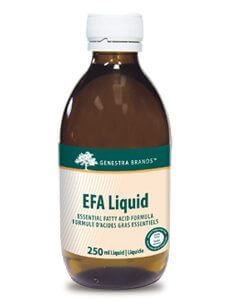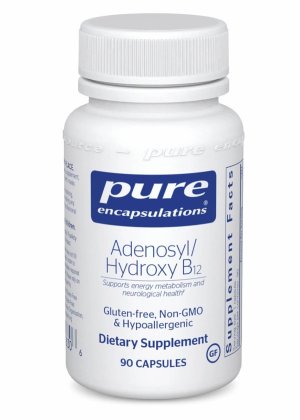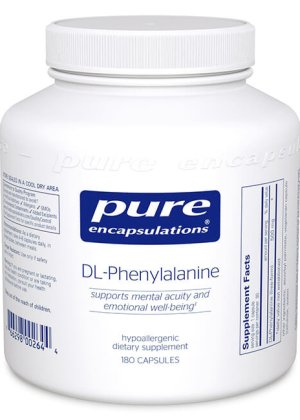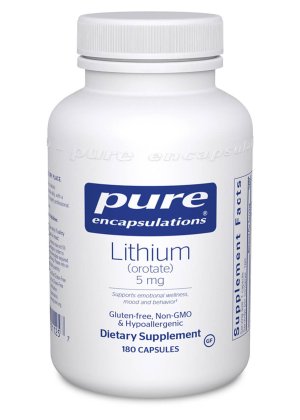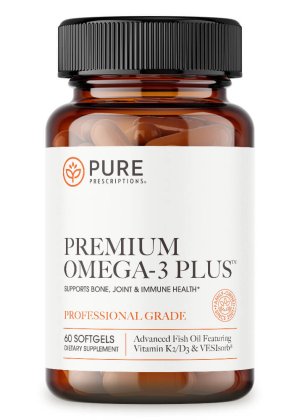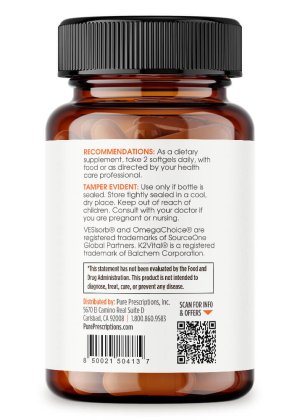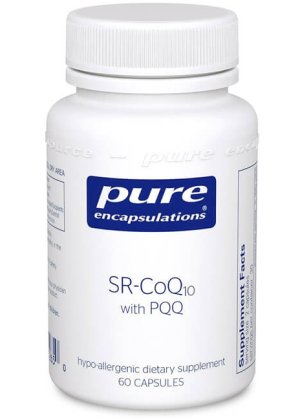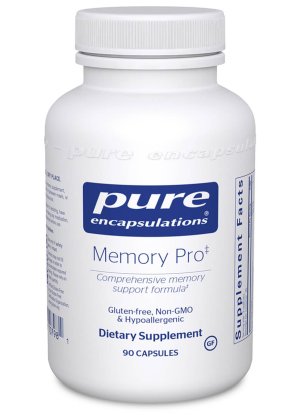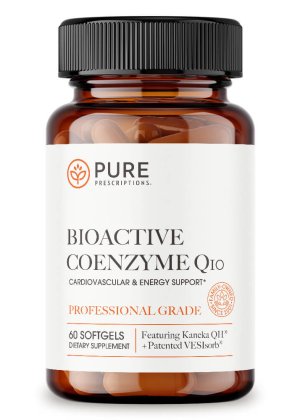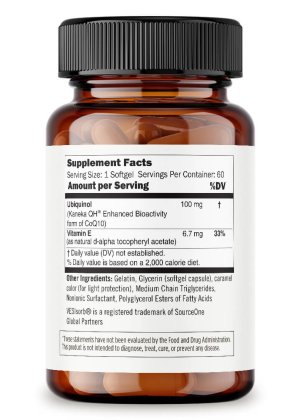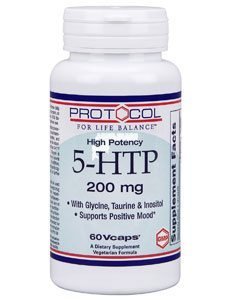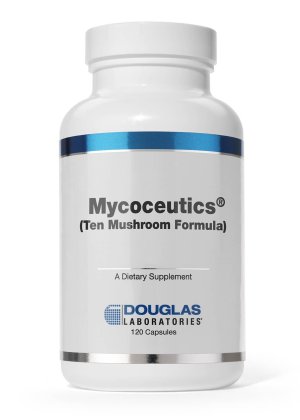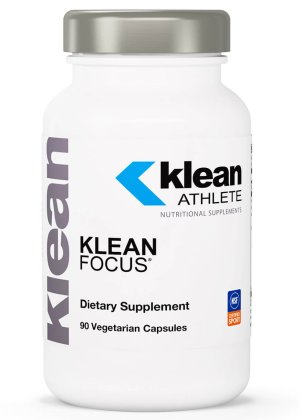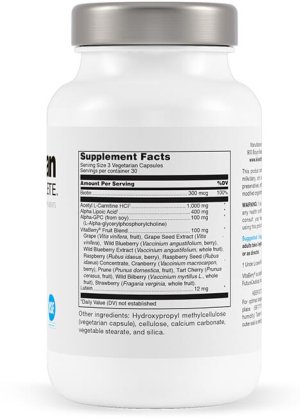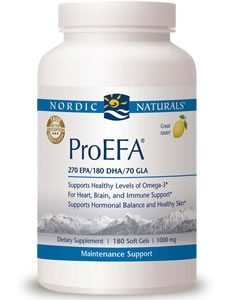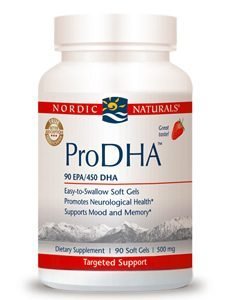EFA Liquid
Suggested Use: Adults: Take two teaspoons three times daily with meals, or as recommended by your healthcare practitioner.
Flaxseed contains 35% of its mass as oil, of which 55% is alpha-linolenic acid (ALA) (13). Human studies have shown that flaxseed and flaxseed oil can modestly reduce serum total and low-density lipoprotein cholesterol (15-50 g/day flaxseed or powder) concentrations, reduce postprandial glucose absorption (40 grams ground flaxseed), decrease some markers of inflammation (14 grams ALA from flaxseed oil), and raise serum levels of the omega-3 fatty acids, ALA and eicosapentaenoic acid (14). The compliance or elasticity of the arterial system, an important index of circulatory function, diminishes with increasing cardiovascular risk. Systemic arterial compliance has been shown to improve through eating of fish and fish oil. Similarly, enhanced arterial compliance was reported following 4 weeks of flaxseed oil supplementation (20 grams ALA from flaxseed oil), in obese subjects (15). Flaxseed oil (14 grams ALA per day or higher) decreases platelet aggregation and increases platelet activating inhibitor-1 and bleeding time (16).
Supplementation with flaxseed oil (2.2 grams) daily led to significant decreases in sensitivity (after nicotinate irritation), Transepidermal Water Loss (TEWL), skin roughness and scaling, while smoothness and hydration were increased in a randomized, double-blind 12-week intervention with 3 female parallel treatment groups (17). The seeds of the evening primrose are rich in omega-6 essential fatty acids (EFAs), including linoleic acid (LA) and gamma-linolenic acid (GLA ). The therapeutic effects of evening primrose oil are attributed to the direct action of its component EFAs on immune cells, as well as their indirect effect on the synthesis of eicosanoids (e.g., prostaglandins, cytokines, cytokine mediators). Oral evening primrose oil (EPO) is best known for its more recent use in the treatment of chronic inflammation, such as atopic dermatitis (0.16 to 0.64 grams GLA)The oil also is used for several women’s health conditions, including breast pain (mastalgia) (0.5 gram EPO containing 0.04 grams GLA and 0.01 gram Vitamin E) (18).
Biophysical skin parameters are indicators of age-related structural and functional changes in skin tissues. Evening primrose oil supplementation (3 grams per day) to healthy adults significantly improved skin moisture, TEWL, elasticity, firmness, fatigue resistance and roughness. These findings lend further support that GLA is a conditionally essential fatty acid for the skin, it is unable to synthesize GLA, and depends on preformed GLA for optimal structure and function (19). Fish oil supplementation during pregnancy not only improves maternal and neonatal DHA status, but often reduces GLA, dihomo-GLA (DGLA), and arachidonic acid (ARA) levels also, which may compromise child development. A study investigating the effects of a fish oil/evening primrose oil (FSO/EPO) blend showed that in women of childbearing age, the tested FSO/EPO blend was well tolerated, appears safe and increases plasma GLA, DGLA, and DHA levels without impairing ARA status (20). Finally, daily doses of 1,200 IU vitamin E, 3,000 mg evening primrose oil, or vitamin E and evening primrose oil in combination at these same dosages taken for six months may decrease the severity of cyclical mastalgia (21).
References: 3 Cottin SC, Sanders TA, Hall WL. The differential effects of EPA and DHA on cardiovascular risk factors. Proc Nutr Soc. 2011 May;70(2):215-31. Abstract 4 Woodman RJ, Mori TA, Burke V, Puddey IB, Watts GF, Beilin LJ. Effects of purified eicosapentaenoic and docosahexaenoic acids on glycemic control, blood pressure, and serum lipids in type 2 diabetic patients with treated hypertension. Am J Clin Nutr. 2002 Nov;76(5):1007-15. Page 1007, Introduction 5 Cottin SC, Sanders TA, Hall WL. The differential effects of EPA and DHA on cardiovascular risk factors. Proc Nutr Soc. 2011 May;70(2):215-31. Abstract; Page 225 Conclusion 6 McDaniel, J.C., Massey, K. and Nicolaou, A. Fish oil supplementation alters levels of lipid mediators of inflammation in microenvironment of acute human wounds. Wound Repair Regen. 2011 Mar-Apr;19(2):189-200. Page 189, Abstract & Introduction 7 van der Meij, B.S., Langius, J.A., Smit, E.F., Spreeuwenberg, M.D., von Blomberg, B.M., Heijboer, A.C., Paul, M.A. and van Leeuwen, P.A. Oral nutritional supplements containing (n-3) polyunsaturated fatty acids affect the nutritional status of patients with stage III non-small cell lung cancer during multimodality treatment . J Nutr. 2010 Oct;140(10):1774-80. Page 1775, 2nd paragraph 8 Cottin SC, Sanders TA, Hall WL. The differential effects of EPA and DHA on cardiovascular risk factors. Proc Nutr Soc. 2011 May;70(2):215-31. Abstract; Page 225 Conclusion 9 Woodman RJ, Mori TA, Burke V, Puddey IB, Watts GF, Beilin LJ. Effects of purified eicosapentaenoic and docosahexaenoic acids on glycemic control, blood pressure, and serum lipids in type 2 diabetic patients with treated hypertension. Am J Clin Nutr. 2002 Nov;76(5):1007-15. Page 1007, Introduction 10 Park, Y. and Harris, W.S. Omega-3 fatty acid supplementation accelerates chylomicron triglyceride clearance. J Lipid Res. 2003 Mar;44(3):455-63. Page 455, Introduction 11 Danthiir V, Burns NR, Nettelbeck T, Wilson C, Wittert G. The Older People, Omega-3, and Cognitive Health (EPOCH) trial design and methodology: A randomised, double-blind, controlled trial investigating the effect of long-chain omega-3 fatty acids on cognitive ageing and wellbeing in cognitively healthy older adults. Nutr J. 2011 Oct 20;10(1):117. Page 2, Background, 2nd paragraph 12 NHPD Monograph on Fish Oil. March 2009. 13 Prasad K. Flaxseed and cardiovascular health. J Cardiovasc Pharmacol. 2009 Nov;54(5):369-77. Page 369, Abstract 14 Bloedon LT, Szapary PO. Flaxseed and cardiovascular risk. Nutr Rev. 2004 Jan;62(1):18-27. Page 18, Abstract 15 Nestel PJ, Pomeroy SE, Sasahara T, Yamashita T, Liang YL, Dart AM, Jennings GL, Abbey M, Cameron JD. Arterial compliance in obese subjects is improved with dietary plant n-3 fatty acid from flaxseed oil despite increased LDL oxidizability. Arterioscler Thromb Vasc Biol. 1997 Jun;17(6):1163-70. Page 1163, Abstract 16 Prasad K. Flaxseed and cardiovascular health. J Cardiovasc Pharmacol. 2009 Nov;54(5):369-77. Page 369, Abstract 17 De Spirt S, Stahl W, Tronnier H, Sies H, Bejot M, Maurette JM, Heinrich U. Intervention with flaxseed and borage oil supplements modulates skin condition in women. Br J Nutr. 2009 Feb;101(3):440-5. Page 440, Abstract; Page 442, Skin Sensitivity, 2nd paragraph; Page 443, Skin hydration & TEWL, skin structure, 1st paragraph + last paragraph; Page 444, Conclusion 18 Bayles B, Usatine R. Evening primrose oil. Am Fam Physician. 2009 Dec 15;80(12):1405-8. Page 1405, Introduction & Pharmacology 19 Muggli R. Systemic evening primrose oil improves the biophysical skin parameters of healthy adults. Int J Cosmet Sci. 2005 Aug;27(4):243-9. Page 243, Abstract 20 Geppert J, Demmelmair H, Hornstra G, Koletzko B. Co-supplementation of healthy women with fish oil and evening primrose oil increases plasma docosahexaenoic acid, gamma-linolenic acid and dihomo-gamma-linolenic acid levels without reducing arachidonic acid concentrations. Br J Nutr. 2008 Feb;99(2):360-9. Page 360, Abstract; Page 360, Introduction, 1st & 2nd paragraphs; Page 367, Conclusion 21 Pruthi S, Wahner-Roedler DL, Torkelson CJ, Cha SS, Thicke LS, Hazelton JH, Bauer BA. Vitamin E and evening primrose oil for management of cyclical mastalgia: a randomized pilot study. Altern Med Rev. 2010 Apr;15(1):59-67. Page 64, Discussion, 1st paragraph; Page 66, Conclusion
Product Ingredients
| Ingredients | AMT | %DV |
|---|---|---|
| Flax (Linum usitatissimum) Seed Oil 17% Yielding ALA (Alpha-Linolenic Acid) 3766 mg * LA (Linoleic Acid) | 7530 mg | - |
| Fish Oil (Sardine and Anchovy) Yielding EPA (Eicosapentaenoic Acid) 160 mg * DHA (Docosahexaenoic Acid) 100 mg * Total Omega-3 Fatty Acids 4050 mg | 1000 mg * | - |
| Evening Primrose (Oenothera biennis) Seed Oil Yielding GLA (Gamma-Linolenic Acid) 28 mg | 280 mg * | - |
Why Buy From Us?Pure Prescriptions is a Family & Employee Owned & Operated Company. Our Customers Have Trusted Us with Their Health Needs for Over 23 Years.

We attribute our longevity to the good old-fashioned business practice of Taking Care of the Customer. Our Aim Is Simple; We want to provide you with the best customer service on the planet.
What We Are NOT: We are not a company owned by Wall Street Money or outside Investors telling us what to do or how to cut corners at the expense of quality products and customer care.
Did You Know: most well known brands (Yes, probably that all-natural brand you love) is owned and supported by big money investors? Oftentimes, the founder isn't even associated with the brand and has since sailed off into the sunset (literally) with a big pay-day...
What We Are: We are an independent, family and employee owned and operated company. We are not owned by Wall Street or any outside investors. We are self-funded, supported by our long-time and loyal customers that we appreciate and serve.
If you're not yet a customer of ours, we'd love the chance to show you how much we care.
We are real humans standing by to answer your health questions. We are here to recommend the right vitamins and supplements for your particular health needs.
Sincerely,
—Dr. Devin Ryerson
Founder & CEO
Helpful Links:
Contact Us | LIVE Chat | Vitamin Quiz
The Pure Prescriptions Difference
When you choose Pure Prescriptions, you become part of our caring community. We’re committed to enhancing your wellness with personalized service, expertly selected products, and a dedication to your health & happiness.


Related products
-
- Vitamin Quiz
- Deals
- Shop
- Brands
- Shop by Manufacturer Brand
- Shop by Manufacturer Brand
- About
- Login

Out of stock





